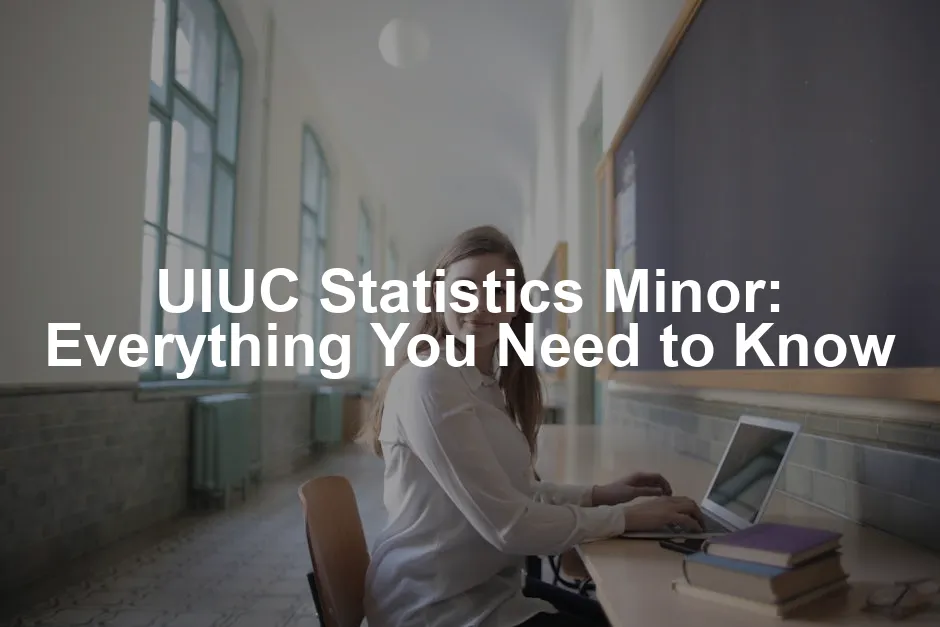Introduction
Welcome to the University of Illinois Urbana-Champaign (UIUC), where data meets opportunity! Known for its exceptional academic programs, UIUC stands out in the realm of statistics. With a vibrant Statistics Department, students are immersed in a world of numbers, analysis, and insights. Here, pursuing a minor in statistics is not just an option; it’s a smart move for students across various disciplines.
Why should you consider a statistics minor? In today’s data-driven landscape, statistical skills are invaluable. Whether you’re majoring in business, social sciences, or natural sciences, understanding data can set you apart from the crowd. Employers are increasingly on the lookout for candidates who can interpret data effectively. A minor in statistics enhances your analytical prowess and prepares you for careers that rely on data analysis.
Moreover, the importance of data analysis skills continues to grow. From marketing to healthcare, industries are leveraging statistics to make informed decisions. A statistics minor equips you with the tools to analyze trends, make predictions, and solve complex problems. Let’s face it: data is everywhere, and being adept at understanding it gives you a competitive edge.
This article serves as your comprehensive guide to the UIUC statistics minor. We’ll cover everything from the minor’s structure to the benefits it offers, ensuring you have all the information needed to make an informed decision. So, buckle up as we explore the fascinating world of statistics and how it can enrich your academic journey!

Overview of the Statistics Minor
What is the Statistics Minor?
The statistics minor at UIUC is designed to provide a solid foundation in statistical inference and applied statistical analysis. This program aims to enhance students’ understanding of data and its applications across various fields. By pursuing this minor, you’ll gain critical skills that are beneficial in an array of disciplines.
So, what can you expect from the program? The objectives of the statistics minor include mastering statistical concepts, interpreting data, and applying various statistical methods. This minor is not just about crunching numbers; it’s about making sense of them. Students will learn to analyze real-world problems and make data-driven decisions.
The benefits of a statistics minor extend beyond the classroom. For students in business, it can enhance understanding of market trends and consumer behavior. In social sciences, statistical analysis is crucial for research. Natural sciences students will find that a solid grasp of statistics is essential for experimental design and interpreting research findings. The versatility of a statistics minor means it complements any major, adding value to your education and career prospects.
If you’re looking to deepen your understanding of statistical methods, consider picking up Statistics: A Very Short Introduction. This book is a fantastic resource to grasp the essential concepts and applications of statistics quickly!

Target Audience
Now, who stands to gain the most from a statistics minor? It’s particularly beneficial for majors like Computer Science, Economics, and Psychology. For Computer Science students, statistical knowledge enhances programming skills and empowers them to tackle data-centric projects. Economics majors will find that statistics is key to understanding economic trends and consumer behavior. Psychology students can utilize statistical methods to analyze research data and draw insightful conclusions.
Beyond these fields, any student looking to enhance their employability should consider this minor. The ability to analyze data and interpret results is a highly sought-after skill in today’s job market. By complementing your major coursework with a statistics minor, you position yourself as a well-rounded candidate ready to tackle complex challenges. In a world where data reigns supreme, being statistically savvy is a game-changer.
Admission and Registration Process
How to Declare the Minor
Ready to take the plunge into the world of statistics at UIUC? Declaring a statistics minor is a straightforward process, or at least it should be! First, you need to contact the Statistics undergraduate advisor. This friendly guide will help you navigate the minor declaration. You’ll find them quite helpful, so don’t hesitate to reach out!
Before officially declaring, make sure you meet the prerequisites. You must have completed calculus through at least MATH 231. This foundational knowledge is key to succeeding in your statistics courses. So, brush off those calculus notes and prepare to impress the advisor!
Once you’ve ticked off the prerequisites and connected with the advisor, your journey begins. You’ll fill out the necessary forms and await confirmation. After that, you’re on your way to enhancing your academic portfolio with a statistics minor!

Registration Considerations
Now, let’s talk registration! The registration process for statistics courses can feel like navigating a minefield, especially with the high demand for these classes. As a minor, you won’t automatically receive priority registration. Many courses are restricted to majors, meaning you may have to be strategic in your selections.
Be prepared to plan ahead. Check the course offerings early and maintain flexibility in your schedule. If you’re aiming for a specific course, keep an eye on registration dates. It’s like waiting for a concert ticket release—timing is everything!
Also, stay informed about any course restrictions. The Statistics Department is continually growing. This means that some classes may become oversubscribed quickly. If a course is full, don’t lose hope. Look for alternatives or consider reaching out to your advisor for guidance. They might have insider tips on how to secure a spot in your desired class.
Overall, while the registration process may seem daunting, with some planning and a proactive approach, you’ll find your way through and make the most of your statistics minor experience!

Course Requirements
Overview of Required Courses
The statistics minor at UIUC requires a commitment of 17-22 credit hours, ensuring you gain a solid foundation in statistical principles. The courses are categorized to help structure your studies effectively.
Statistical Concepts
First up, you’ll need to dive into Statistical Concepts. Here are your options:
- STAT 100: Statistics – A great entry point for beginners.
- STAT 107: Data Science Discovery – Perfect for those interested in data-centric careers.
- ACE 261: Applied Statistical Methods – Useful for agriculture and consumer economics.
- CPSC 241: Intro to Applied Statistics – Tailored for computer science enthusiasts.
- ECON 202: Economic Statistics I – Ideal if you’re into economics.
- EPSY 280: Elements of Statistics – Focuses on educational contexts.
- PSYC 235: Intro to Statistics – A must for psychology majors.
- SOC 280: Intro to Social Statistics – Great for sociology students.
Pick one of these courses to kick off your minor!

To really boost your understanding, consider reading The Art of Statistics: Learning from Data. This book dives into practical applications of statistics that are both engaging and informative!
Data Analysis
Next, you’ll delve into Data Analysis. Select one from the following:
- STAT 200: Statistical Analysis – A staple in the statistics curriculum.
- STAT 207: Data Science Exploration – For those eager to explore data science.
- STAT 212: Biostatistics – Excellent for health sciences students.
- ECON 203: Economic Statistics II – A continuation for economics majors.
This category is all about applying what you’ve learned in real-world situations. For more insights on effective data analysis, check out tips for effective data analysis in economics and statistics.

Understanding data analysis is crucial for success in various fields. Tips for effective data analysis in economics and statistics can enhance your skills in this area.
Linear Algebra
Don’t underestimate the importance of Linear Algebra! Choose one course from:
- MATH 225: Introductory Matrix Theory – Focuses on the theory behind matrices.
- MATH 257: Linear Algebra with Computational Applications – Perfect for those who love practical applications.
- MATH 415: Applied Linear Algebra – For a more advanced take.
Linear algebra is key to understanding many statistical methods. So choose wisely!
As you can see, the course requirements for a statistics minor at UIUC are structured to provide a well-rounded education in statistical methods and applications. By carefully selecting your courses, you’ll build a powerful skill set that enhances your major and prepares you for future career opportunities. So gear up and get ready to crunch those numbers!

Speaking of crunching numbers, if you want to dive deeper into statistical learning, consider grabbing An Introduction to Statistical Learning. This book offers a great mix of theory and practice that can enhance your understanding of data science!
Mathematical Statistics
In the UIUC statistics minor, taking a course in Mathematical Statistics is essential. You’ll have a couple of stellar options: STAT 400 and ASRM 401.
STAT 400: Statistics and Probability I is a foundational course. It covers the essential principles of statistical theory. Expect to tackle probability distributions, estimation, and hypothesis testing. This course is vital for students aiming to understand the “why” behind statistical methods.
On the other hand, ASRM 401: Actuarial Statistics I leans towards the actuarial side. If you’re eyeing a career in insurance or risk analysis, this course is tailored for you. You’ll learn about various statistical techniques used in actuarial practice, making it a great fit for students focused on finance or insurance.
Both courses provide a solid grounding in statistical concepts, preparing you for advanced topics and practical applications.

Advanced Statistical Methods
When it comes to Advanced Statistical Methods, you have a buffet of elective courses to choose from. Here are some noteworthy options:
- STAT 420: Methods of Applied Statistics focuses on practical techniques for data analysis. You’ll learn regression, ANOVA, and more, making it perfect for those who want hands-on experience.
- STAT 425: Statistical Modeling I dives into predictive modeling and data mining. If machine learning is your jam, this is a must-take course.
- Other electives include STAT 424: Design of Experiments, STAT 426: Statistical Modeling II, and STAT 428: Statistical Computing. Each course builds upon the skills learned in previous classes, allowing you to specialize in areas that intrigue you most.
Incorporating these advanced methods into your studies amplifies your analytical toolkit. Plus, they’re highly relevant in industries like tech, healthcare, and finance, where data-driven decision-making reigns supreme.

If you want to get a solid grasp on data science, consider R for Data Science. This book will guide you through importing, transforming, and visualizing data like a pro!
Sample Course Path
Wondering how to weave these courses into your schedule? Here’s a potential course path for students progressing through the minor:
- Freshman Year:
- Fall: STAT 100 or STAT 107 (Statistical Concepts)
- Spring: MATH 225 or MATH 257 (Linear Algebra)
- Sophomore Year:
- Fall: STAT 200 or STAT 207 (Data Analysis)
- Spring: STAT 400 or ASRM 401 (Mathematical Statistics)
- Junior Year:
- Fall: STAT 420 or STAT 425 (Advanced Statistical Methods)
- Spring: Elective (choose from STAT 424, 426, 428, etc.)
- Senior Year:
- Fall: Additional elective (dependent on your focus area)
- Spring: Final elective or capstone project (if available)
This course path allows you to build a robust understanding while exploring various statistical applications. You’ll end up not just with a minor, but with a treasure trove of skills that can make you an asset in the job market.

Career Opportunities
Job Market Relevance
In today’s job market, statistical skills are as hot as a fresh cup of coffee on a Monday morning. Employers are eager for candidates who can analyze data and draw meaningful conclusions. A minor in statistics from UIUC positions you to stand out among the crowd.
Industries like finance, healthcare, marketing, and technology have a keen eye for data analysis skills. In finance, companies rely on statistical models to predict market trends. Healthcare professionals utilize statistics to analyze patient data and improve outcomes. Marketing teams depend on data to understand consumer behavior, optimize campaigns, and measure success. Even tech giants look for data-savvy individuals to enhance their products and services.

According to the Bureau of Labor Statistics, jobs that require statistical skills are projected to grow significantly in the coming years. This growth is fueled by the increasing reliance on data-driven decision-making. So, whether you’re dreaming of diving into the world of finance or exploring the tech landscape, a statistics minor is your golden ticket.
Examples of Careers
With a statistics minor under your belt, the career options are plentiful. Let’s take a look at some of the exciting career paths available to you:
- Data Analyst: These professionals sift through data to uncover trends and insights. They help organizations make informed decisions based on solid data analysis.
- Statistician: Statisticians design surveys and experiments to collect data. They analyze the results and present findings to stakeholders. This role often requires creativity in problem-solving. For more information on becoming a statistician, see statistics for nonstatisticians wissing.
- Research Scientist: In this role, you’ll utilize statistical methods to conduct research in various fields, such as social sciences, health sciences, or market research. Your findings can significantly impact policies or product development.
- Market Research Analyst: These analysts study market conditions to understand potential sales of a product or service. They use data to help companies tailor their marketing strategies effectively.
- Biostatistician: A specialized type of statistician, biostatisticians work in healthcare and pharmaceutical industries. They analyze data from clinical trials to help develop new treatments and drugs.
- Actuary: Actuaries use statistics to assess risk in insurance and finance. They evaluate the likelihood of events occurring, which is crucial for setting premiums.
- Quantitative Analyst: Often found in finance, quantitative analysts use statistical models to identify investment opportunities and manage risks for portfolios.
Each of these career paths leverages the analytical skills gained from a statistics minor. With the growing demand for data professionals, the future looks bright for those with a statistics background. So, why not enhance your academic journey and explore the endless opportunities that await?

Don’t forget to equip yourself with the right tools to stay productive! Consider getting an HP Envy 6055 Wireless All-in-One Printer. It’s perfect for printing out your assignments and notes, making your study sessions smoother!
Conclusion
In summary, pursuing a statistics minor at UIUC is an excellent investment in your future. As we’ve explored, the relevance of statistical skills in today’s job market cannot be overstated. Industries across the board are on the lookout for individuals who can analyze data and provide insights that drive decisions.
From finance to healthcare, marketing to technology, a statistics minor complements your major, enriching your understanding of data analysis. Additionally, the career paths available to you, from data analyst to actuary, showcase the versatility and demand for statistical skills.
Ultimately, adding a statistics minor to your academic plan can open doors to a wealth of opportunities. It not only enhances your skill set but also makes you a more attractive candidate in the job market. If you’re looking to elevate your career prospects and make a meaningful impact in your field, consider adding a statistics minor at UIUC. Your future self will thank you for it!
FAQs
What are the prerequisites for the statistics minor?
To pursue a statistics minor at UIUC, students must have completed calculus through at least MATH 231. This is a crucial foundation for understanding statistical methods. Be sure to check the course explorer for any additional prerequisites specific to the courses you plan to take. Without this calculus background, you may find some of the statistical concepts a bit daunting. So, brush up on your calculus skills!
Can I pursue the statistics minor alongside a demanding major?
Absolutely! Many students successfully juggle a statistics minor with their major. However, time management is key. Balancing coursework requires strategic planning. Consider taking one course per semester to avoid overload. If you’re already facing a heavy schedule, summer courses can be a great option to lighten your load during the academic year. Just remember to keep your calendar organized!
What resources are available for students struggling with the coursework?
The Statistics Department offers several resources for students who may need extra help. First up, tutoring sessions are available. These can provide personalized guidance and support. Additionally, study groups are a fantastic way to collaborate with peers, making complex concepts easier to grasp. Don’t forget about office hours! Professors are often more than happy to help students understand the material better. So, don’t be shy—reach out for help when needed!
Is it possible to take courses in the summer to complete the minor?
Yes! Taking summer courses is a great way to accelerate your progress toward completing the minor. UIUC offers several statistics courses during the summer, allowing you to catch up or get ahead. Just check the course catalog for availability and registration deadlines. This option can provide more flexibility in your regular academic year schedule, making it easier to manage your overall coursework.
How does the statistics minor enhance my resume?
A minor in statistics adds a powerful credential to your resume. It demonstrates your analytical skills and ability to work with data—traits highly sought after by employers. In an era where data drives decision-making, having a statistics minor shows you can interpret data effectively. This minor can distinguish you from other candidates, making you a more appealing choice for potential employers. So, go ahead and flaunt that minor!
Please let us know what you think about our content by leaving a comment down below!
Thank you for reading till here 🙂
And if you want to keep track of your fitness while you study, check out the FitBit Charge 5. This fitness tracker can help you stay motivated and healthy while balancing your academic workload!
All images from Pexels




